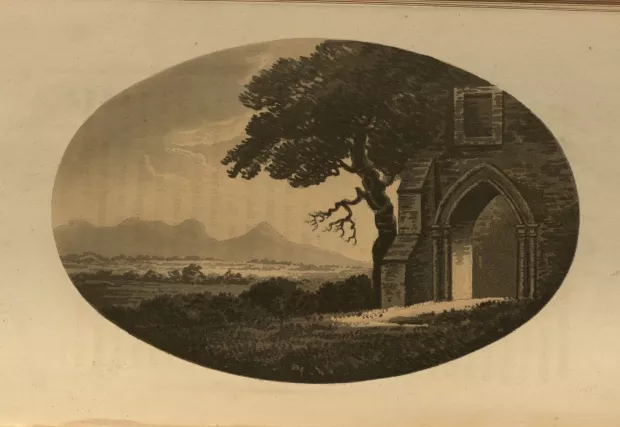Creation Date
1800
Height
11 cm
Width
16 cm
Medium
Genre
Description
The façade of a brick structure—with a sidewall jutting out to form a kind of corner—and a tree with a serpentine trunk take up the right half of the oval-shaped image. Light shining through the arched portal punctuates the façade and illumines the patch of grass before the entrance. A blind (blocked up) window is built into the wall just above this portal. A grassy area occupies the center foreground. Land stretches into the distance, past a field and a row of trees to a body of water. In the far background a mountain range is silhouetted against a sky vaguely brushed with clouds. This historically artificial ruin does not look like a ruin. Consequently, Raglan Castle serves to reveal some of the compositional practices of the picturesque aesthetic.
Of the damages inflicted on the castle by Oliver Cromwell, William Gilpin writes: “Raglan-castle owes its present picturesque to Cromwell; who laid his iron hands upon it; and shattered it into ruin.” Although Cromwell’s exploits were meant to destroy Raglan, Gilpin is here referring to contemporary practices of artificial ruination. Gilpin himself advocated manually damaging ruins “[t]o give the stone its [desired, picturesque] mouldering [sic] appearance” (Gilpin qtd. in Lowenthal: 157-58). Raglan Castle was artificially modified to look like a ruin, but the structure itself is sound, and gives no signs of ruination. No part of the façade is in any state of decay, and the portal, like the blind window above it, is perfectly formed.
I would refer to Raglan Castle as a “neo-Gothic ruin” because of its parallels with the early nineteenth-century Neo-Gothic movement, otherwise known as the Gothic Revival (“Gothic Revival”). This trend in architectural design began in Britain, derived its inspiration from medieval structures, and usually entailed the embellishment of modern gothic architecture with medieval gothic themes. Similarly, the ruin-like features of Raglan Castle were artificially created or exaggerated in an attempt to make it adhere to the picturesque aesthetic; however, Gilpin has also effaced any sign of decay. As a result, this image presents an unusual contradiction in comparison of other depicted, picturesque ruins.
Associated Works
Locations Description
Wye River
The Wye River, one of the major rivers in Britain, runs through Wales and England. North Wales in particular became a popular picturesque tourist destination in the later half of the eighteenth century.
Boldre
One of Gilpin’s former students at Cheam, Colonel William Mitford, heard of his former schoolmaster’s desire to retire from the school at Cheam and offered him a wage in Boldre. Gilpin accepted, and he served as the Vicar of Boldre, Hampshire from 1777 until his death in 1804 (Templeman 148). From the beginning of this appointment until 1791, he kept up his drawing while attending to the affairs of his new parish community. He initiated an association to aid the impoverished in the neighboring town of Lymington and supported the foundation of Sunday and day schools in Boldre (Templeman 186-91). The revenues from sales of his Tours allowed him to establish two schools in Boldre in 1791 (Gilpin: qtd. in Templeman 194). Between 1797 and 1800, a period of prolonged illness, he published another set of sermons and additional accounts of his domestic travels (Observations on the Western Parts of England), as well as working to arrange the the posthumous sale of his works in order to establish an endowment for his schools (Barbier 92; Templeman 207-9).
Copyright
Copyright 2009, Department of Special Collections, Memorial Library, University of Wisconsin-Madison, Madison, WI
Publisher
R. Blamire
Collection
Additional Information
Bibliography
"Gothic Revival." Encyclopædia Britannica. 2009. Encyclopædia Britannica Online. 16 May 2009 http://www.search.eb.com/eb/article-9037492.
Andrews, Malcolm. The Search for the Picturesque: Landscape Aesthetics and Tourism in Britain, 1760-1800. Stanford: Stanford UP, 1989. Print.
Barbier, Carl Paul. William Gilpin: His Drawings, Teaching, and Theory of the Picturesque. Oxford: Clarendon P, 1963. Print.
Bermingham, Ann. "The Picturesque and Ready-to-wear Femininity." The Politics of the Picturesque: Literature, Landscape, and Aesthetics since 1770. Ed. Stephen Copley and Peter Garside. Cambridge: Cambridge UP, 1994. Print. 81-119.
Gilpin, William. An Essay on Prints. Third ed. London, 1781. Eighteenth Century Collections Online. Gale. University of Wisconsin—Madison. Web. 21 May 2009.
Gilpin, William. Observations on the Western Parts of England, Relative Chiefly to Picturesque Beauty. To which Are Added, a Few Remarks on . . . the Isle of Wight. London, 1798. Eighteenth Century Collections Online. Gale. Web. University of Wisconsin - Madison. 16 May 2009.
Gilpin, William. Observations, Relative Chiefly to Picturesque Beauty, Made in the Year 1772, on Several Parts of England; Particularly the Mountains, and Lakes of Cumberland, and Westmoreland. Vol. 1. 3rd ed. London, 1792. Eighteenth Century Collections Online. Gale. University of Wisconsin - Madison. Web. 16 May 2009.
---. Three Essays: On Picturesque beauty; On Picturesque Travel; and On Sketching Landscape: To which Is Added a Poem, on Landscape Painting. London, 1792. Eighteenth Century Collections Online. Gale. University of Wisconsin - Madison. Web. 21 May 2009.
Lowenthal, David. The Past is a Foreign Country. Cambridge: Cambridge UP, 1985. Print.
Templeman, William D. The Life and Work of William Gilpin (1724-1804): Master of the Picturesque and Vicar of Boldre. Urbana: U of Illinois P, 1939. Print. University of Illinois Studies in Language and Literature 24.3-4.

